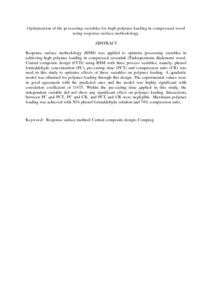Citation
Ashaari, Zaidon and Bakar, Edi Suhaimi and Md. Tahir, Paridah and Kim, G.H. and Rushdan, I.
(2012)
Optimization of the processing variables for high polymer loading in compressed wood using response surface methodology.
Journal of Tropical Forest Science, 24 (2).
pp. 241-248.
ISSN 0128-1283
Abstract
Response surface methodology (RSM) was applied to optimise processing variables in achieving high polymer loading in compressed sesenduk (Endospermum diadenum) wood. Central composite design (CCD) using RSM with three process variables, namely, phenol formaldehyde concentration (PC), pre-curing time (PCT) and compression ratio (CR) was used in this study to optimise effects of these variables on polymer loading. A quadratic model was obtained for polymer loading through this design. The experimental values were in good agreement with the predicted ones and the model was highly significant with correlation coefficient of 0.915. Within the pre-curing time applied in this study, the independent variable did not show any significant effect on polymer loading. Interactions between PC and PCT, PC and CR, and PCT and CR were negligible. Maximum polymer loading was achieved with 36% phenol formaldehyde solution and 74% compression ratio.
Download File
![[img]](http://psasir.upm.edu.my/24008/1.hassmallThumbnailVersion/Optimization%20of%20the%20processing%20variables%20for%20high%20polymer%20loading%20in%20compressed%20wood%20using%20response%20surface%20methodology.pdf)  Preview |
|
PDF (Abstract)
Optimization of the processing variables for high polymer loading in compressed wood using response surface methodology.pdf
Download (84kB)
| Preview
|
|
Additional Metadata
Actions (login required)
 |
View Item |

